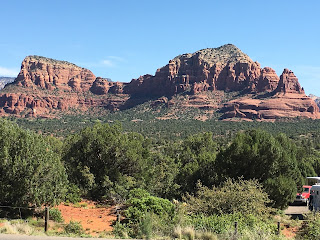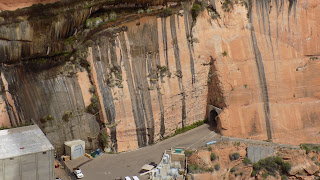We met Scott, Leigh and Julia in Oak Creek about 7 miles outside Sedona for dinner. They had flown into Phoenix, stopped by to see us at the RV and then driven to Sedona. It was a nice dinner with an early evening. OnSatuday, we moved to Rancho Sedona RV Park in Sedona to be closer to the kids. Sedona is breath taking.
Saturday and Sunday we just spent time together catching up. Monday we began our sight seeing with a visit to Montezuma's Castle National Monument. We found out that there were numerous Sinagua communities throughout the Verde Valley and this, like Tuzigoot, was one. However, the homes certainly looked different. Perched next to the Verde river was a community of 45 rooms high on a cliff side 100 feet up. The houses were built sometime between 1100 and 1300 AD. The people were farmers, raising corn, squash, beans and cotton. The ruins were discovered by Spanish exploration in the 1400's but then went untouched for over 200 years. Early American settlers thought it was Aztec and thus the totally incorrect name, Montezuma's Castle.
The apartments could only be accessed via ladders, now long gone. Over the years looters stole hundreds of artifacts. In 1906, President Teddy Roosevelt, made Montezuma's Castle a National Monument.
He was a president who had the foresight to save our history as opposed to the President who would be king along with his royal family. Trump announced his latest executive order where he wants to remove national monument status from a number of monuments created by the last three presidents. The directive is part of a broader push to open up more federal lands to drilling, mining and other development. Another opportunity to put more money in the hands of his billionaire buddies like Tillerson and the Koch brothers while the man on the street gets shafted again. This was the man who proclaimed his commitment to preserving America’s “natural resources and beauty" during a speech on Earth Day. He went on to say, "Our Nation is blessed with abundant natural resources and awe-inspiring beauty. Americans are rightly grateful for these God-given gifts and have an obligation to safeguard them for future generations,”
“My Administration is committed to keeping our air and water clean, to preserving our forests, lakes, and open spaces, and to protecting endangered species,”. Oops, sorry, didn't mean that. 452 documented lies in 98 days.
Next time, on to Jerome, AZ and the Grand Canyon.


















































